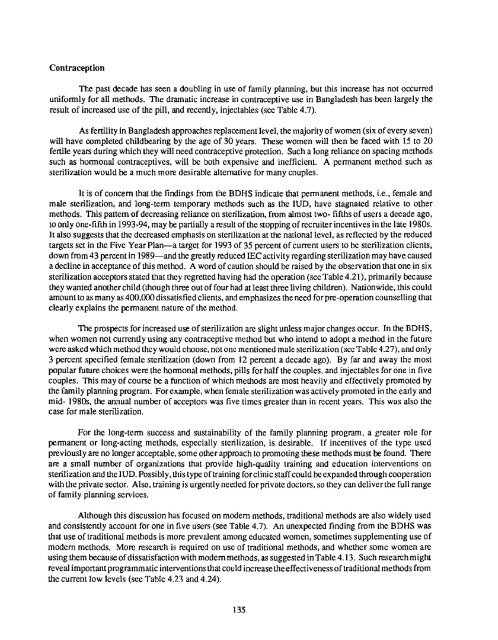Bangladesh 1993-1994 Demographic and Health ... - Measure DHS
Bangladesh 1993-1994 Demographic and Health ... - Measure DHS
Bangladesh 1993-1994 Demographic and Health ... - Measure DHS
- No tags were found...
Create successful ePaper yourself
Turn your PDF publications into a flip-book with our unique Google optimized e-Paper software.
ContraceptionThe past decade has seen a doubling in use of family planning, but this increase has not occurreduniformly for all methods. The dramatic increase in contraceptive use in <strong>Bangladesh</strong> has been largely theresult of increased use of the pill, <strong>and</strong> recently, injectables (see Table 4.7).As fertility in <strong>Bangladesh</strong> approaches replacement level, the majority of women (six of every seven)will have completed childbearing by the age of 30 years. These women will then be faced with 15 to 20fertile years during which they will need contraceptive protection. Such a long reliance on spacing methodssuch as hormonal contraceptives, will be both expensive <strong>and</strong> inefficient. A permanent method such assterilization would be a much more desirable alternative for many couples.It is of concern that the findings from the B<strong>DHS</strong> indicate that permanent methods, i.e., female <strong>and</strong>male sterilization, <strong>and</strong> long-term temporary methods such as the IUD, have stagnated relative to othermethods. This pattern of decreasing reliance on sterilization, from almost two- fifths of users a decade ago,to only one-fifth in <strong>1993</strong>-94, may be partially a result of the stopping of recruiter incentives in the late 1980s.It also suggests that the decreased emphasis on sterilization at the national level, as reflected by the reducedtargets set in the Five Year Plan--a target for <strong>1993</strong> of 35 percent of current users to be sterilization clients,down from 43 percent in 1989--<strong>and</strong> the greatly reduced IEC activity regarding sterilization may have causeda decline in acceptance of this method. A word of caution should be raised by the observation that one in sixsterilization acceptors stated that they regretted having had the operation (see Table 4.21), primarily becausethey wanted another child (though three out of four had at least three living children). Nationwide, this couldamount to as many as 400,000 dissatisfied clients, <strong>and</strong> emphasizes the need for pre-operation counselling thatclearly explains the permanent nature of the method.The prospects for increased use of sterilization are slight unless major changes occur. In the B<strong>DHS</strong>,when women not currently using any contraceptive method but who intend to adopt a method in the futurewere asked which method they would choose, not one mentioned male sterilization (see Table 4.27), <strong>and</strong> only3 percent specified female sterilization (down from 12 percent a decade ago). By far <strong>and</strong> away the mostpopular future choices were the hormonal methods, pills for half the couples, <strong>and</strong> injectables for one in fivecouples. This may of course be a function of which methods are most heavily <strong>and</strong> effectively promoted bythe family planning program. For example, when female sterilization was actively promoted in the early <strong>and</strong>mid- 1980s, the annual number of acceptors was five times greater than in recent years. This was also thecase for male sterilization.For the long-term success <strong>and</strong> sustainability of the family planning program, a greater role forpermanent or long-acting methods, especially sterilization, is desirable. If incentives of the type usedpreviously are no longer acceptable, some other approach to promoting these methods must be found. Thereare a small number of organizations that provide high-quality training <strong>and</strong> education interventions onsterilization <strong>and</strong> the IUD. Possibly, this type of training for clinic staffcould be exp<strong>and</strong>ed through cooperationwith the private sector. Also, training is urgently needed for private doctors, so they can deliver the full rangeof family planning services.Although this discussion has focused on modem methods, traditional methods are also widely used<strong>and</strong> consistently account for one in five users (see Table 4.7). An unexpected finding from the B<strong>DHS</strong> wasthat use of traditional methods is more prevalent among educated women, sometimes supplementing use ofmodem methods. More research is required on use of traditional methods, <strong>and</strong> whether some women areusing them because of dissatisfaction with modem methods, as suggested in Table 4.13. Such research mightreveal important programmatic interventions that could increase the effectiveness of traditional methods fromthe current low levels (see Table 4.23 <strong>and</strong> 4.24).135








![Obtaining Informed Consent for HIV Testing [QRS4] - Measure DHS](https://img.yumpu.com/49850117/1/190x245/obtaining-informed-consent-for-hiv-testing-qrs4-measure-dhs.jpg?quality=85)







